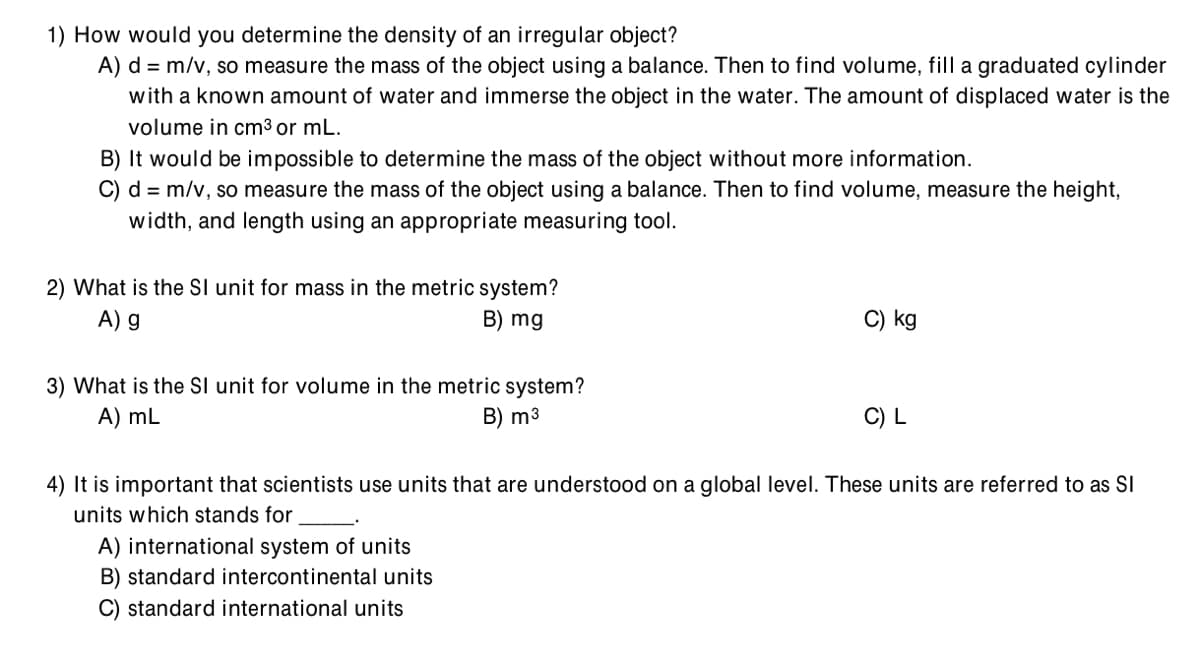1) How would you determine the density of an irregular object? A) d = m/v, so measure the mass of the object using a balance. Then to find volume, fill a graduated cylinder with a known amount of water and immerse the object in the water. The amount of displaced water is the volume in cm³ or mL. B) It would be impossible to determine the mass of the object without more information. C) d = m/v, so measure the mass of the object using a balance. Then to find volume, measure the height, width, and length using an appropriate measuring tool.
1) How would you determine the density of an irregular object? A) d = m/v, so measure the mass of the object using a balance. Then to find volume, fill a graduated cylinder with a known amount of water and immerse the object in the water. The amount of displaced water is the volume in cm³ or mL. B) It would be impossible to determine the mass of the object without more information. C) d = m/v, so measure the mass of the object using a balance. Then to find volume, measure the height, width, and length using an appropriate measuring tool.
Chemistry
10th Edition
ISBN:9781305957404
Author:Steven S. Zumdahl, Susan A. Zumdahl, Donald J. DeCoste
Publisher:Steven S. Zumdahl, Susan A. Zumdahl, Donald J. DeCoste
Chapter1: Chemical Foundations
Section: Chapter Questions
Problem 1RQ: Define and explain the differences between the following terms. a. law and theory b. theory and...
Related questions
Question

Transcribed Image Text:1) How would you determine the density of an irregular object?
A) d = m/v, so measure the mass of the object using a balance. Then to find volume, fill a graduated cylinder
with a known amount of water and immerse the object in the water. The amount of displaced water is the
volume in cm³ or mL.
B) It would be impossible to determine the mass of the object without more information.
C) d = m/v, so measure the mass of the object using a balance. Then to find volume, measure the height,
width, and length using an appropriate measuring tool.
2) What is the SI unit for mass in the metric system?
A) g
B) mg
C) kg
3) What is the Sl unit for volume in the metric system?
A) mL
B) m3
C) L
4) It is important that scientists use units that are understood on a global level. These units are referred to as SI
units which stands for
A) international system of units
B) standard intercontinental units
C) standard international units
Expert Solution
This question has been solved!
Explore an expertly crafted, step-by-step solution for a thorough understanding of key concepts.
This is a popular solution!
Trending now
This is a popular solution!
Step by step
Solved in 2 steps

Knowledge Booster
Learn more about
Need a deep-dive on the concept behind this application? Look no further. Learn more about this topic, chemistry and related others by exploring similar questions and additional content below.Recommended textbooks for you

Chemistry
Chemistry
ISBN:
9781305957404
Author:
Steven S. Zumdahl, Susan A. Zumdahl, Donald J. DeCoste
Publisher:
Cengage Learning

Chemistry
Chemistry
ISBN:
9781259911156
Author:
Raymond Chang Dr., Jason Overby Professor
Publisher:
McGraw-Hill Education

Principles of Instrumental Analysis
Chemistry
ISBN:
9781305577213
Author:
Douglas A. Skoog, F. James Holler, Stanley R. Crouch
Publisher:
Cengage Learning

Chemistry
Chemistry
ISBN:
9781305957404
Author:
Steven S. Zumdahl, Susan A. Zumdahl, Donald J. DeCoste
Publisher:
Cengage Learning

Chemistry
Chemistry
ISBN:
9781259911156
Author:
Raymond Chang Dr., Jason Overby Professor
Publisher:
McGraw-Hill Education

Principles of Instrumental Analysis
Chemistry
ISBN:
9781305577213
Author:
Douglas A. Skoog, F. James Holler, Stanley R. Crouch
Publisher:
Cengage Learning

Organic Chemistry
Chemistry
ISBN:
9780078021558
Author:
Janice Gorzynski Smith Dr.
Publisher:
McGraw-Hill Education

Chemistry: Principles and Reactions
Chemistry
ISBN:
9781305079373
Author:
William L. Masterton, Cecile N. Hurley
Publisher:
Cengage Learning

Elementary Principles of Chemical Processes, Bind…
Chemistry
ISBN:
9781118431221
Author:
Richard M. Felder, Ronald W. Rousseau, Lisa G. Bullard
Publisher:
WILEY